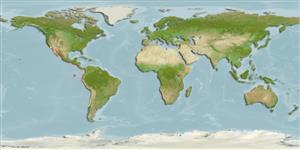Preferred temperature (Ref.
123201): 20.8 - 26.9, mean 22.6 °C (based on 20 cells).
Phylogenetic diversity index (Ref.
82804): PD
50 = 0.6250 [Uniqueness, from 0.5 = low to 2.0 = high].
Bayesian length-weight: a=0.02570 (0.01232 - 0.05364), b=2.94 (2.77 - 3.11), in cm total length, based on LWR estimates for this (Sub)family-body shape (Ref.
93245).
Trophic level (Ref.
69278): 3.4 ±0.40 se; based on food items.
Widerstandsfähigkeit (Ref.
120179): niedrig, Verdopplung der Population dauert 4,5 - 14 Jahre. (Preliminary K or Fecundity.).
Fishing Vulnerability (Ref.
59153): High vulnerability (60 of 100).
Nutrients (Ref.
124155): Calcium = 20.9 [8.5, 47.4] mg/100g; Iron = 0.457 [0.229, 1.005] mg/100g; Protein = 18.6 [16.4, 20.7] %; Omega3 = 0.0892 [, ] g/100g; Selenium = 43.6 [19.0, 92.6] μg/100g; VitaminA = 34.4 [9.2, 123.8] μg/100g; Zinc = 0.83 [0.56, 1.25] mg/100g (wet weight);
